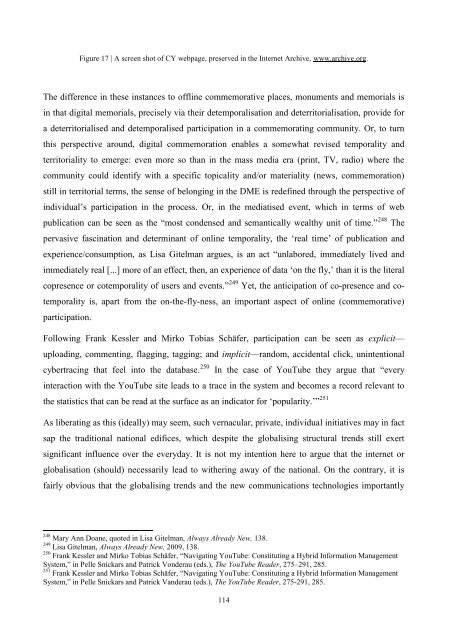UNIVERSITY OF NOVA GORICA GRADUATE SCHOOL ...
UNIVERSITY OF NOVA GORICA GRADUATE SCHOOL ...
UNIVERSITY OF NOVA GORICA GRADUATE SCHOOL ...
You also want an ePaper? Increase the reach of your titles
YUMPU automatically turns print PDFs into web optimized ePapers that Google loves.
Figure 17 | A screen shot of CY webpage, preserved in the Internet Archive, www.archive.org.<br />
The difference in these instances to offline commemorative places, monuments and memorials is<br />
in that digital memorials, precisely via their detemporalisation and deterritorialisation, provide for<br />
a deterritorialised and detemporalised participation in a commemorating community. Or, to turn<br />
this perspective around, digital commemoration enables a somewhat revised temporality and<br />
territoriality to emerge: even more so than in the mass media era (print, TV, radio) where the<br />
community could identify with a specific topicality and/or materiality (news, commemoration)<br />
still in territorial terms, the sense of belonging in the DME is redefined through the perspective of<br />
individual‘s participation in the process. Or, in the mediatised event, which in terms of web<br />
publication can be seen as the ―most condensed and semantically wealthy unit of time.‖ 248 The<br />
pervasive fascination and determinant of online temporality, the ‗real time‘ of publication and<br />
experience/consumption, as Lisa Gitelman argues, is an act ―unlabored, immediately lived and<br />
immediately real [...] more of an effect, then, an experience of data ‗on the fly,‘ than it is the literal<br />
copresence or cotemporality of users and events.‖ 249 Yet, the anticipation of co-presence and cotemporality<br />
is, apart from the on-the-fly-ness, an important aspect of online (commemorative)<br />
participation.<br />
Following Frank Kessler and Mirko Tobias Schäfer, participation can be seen as explicit—<br />
uploading, commenting, flagging, tagging; and implicit—random, accidental click, unintentional<br />
cybertracing that feel into the database. 250 In the case of YouTube they argue that ―every<br />
interaction with the YouTube site leads to a trace in the system and becomes a record relevant to<br />
the statistics that can be read at the surface as an indicator for ‗popularity.‘‖ 251<br />
As liberating as this (ideally) may seem, such vernacular, private, individual initiatives may in fact<br />
sap the traditional national edifices, which despite the globalising structural trends still exert<br />
significant influence over the everyday. It is not my intention here to argue that the internet or<br />
globalisation (should) necessarily lead to withering away of the national. On the contrary, it is<br />
fairly obvious that the globalising trends and the new communications technologies importantly<br />
248 Mary Ann Doane, quoted in Lisa Gitelman, Always Already New, 138.<br />
249 Lisa Gitelman, Always Already New, 2009, 138.<br />
250 Frank Kessler and Mirko Tobias Schäfer, ―Navigating YouTube: Constituting a Hybrid Information Management<br />
System,‖ in Pelle Snickars and Patrick Vonderau (eds.), The YouTube Reader, 275–291, 285.<br />
251 Frank Kessler and Mirko Tobias Schäfer, ―Navigating YouTube: Constituting a Hybrid Information Management<br />
System,‖ in Pelle Snickars and Patrick Vanderau (eds.), The YouTube Reader, 275-291, 285.<br />
114

















